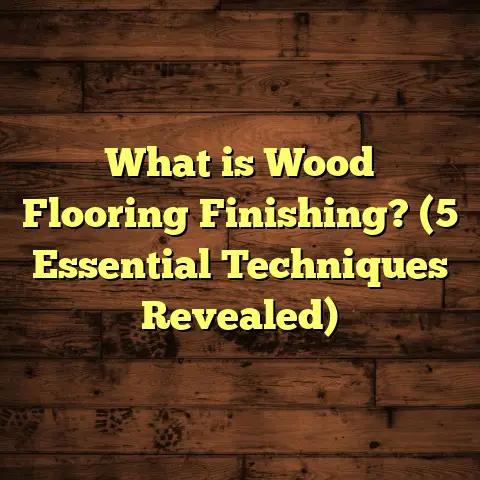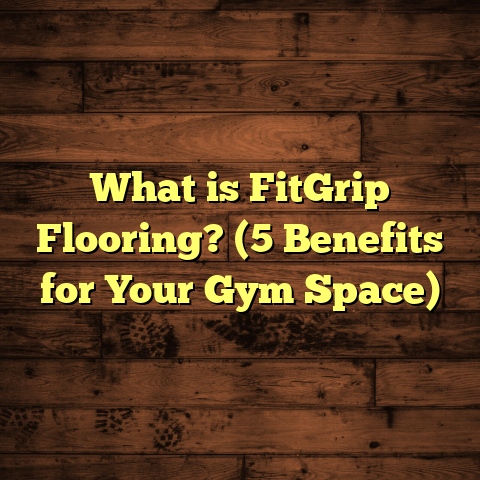What is Solid Core Vinyl Plank Flooring? (5 Reasons to Choose It!)
Cost-effectiveness is one of those things I always weigh heavily when it comes to home improvement projects. Flooring, in particular, can be a massive investment, and balancing quality with budget isn’t always easy. When I first got into solid core vinyl plank flooring, it struck me as an affordable yet resilient option that didn’t force me to compromise on style or durability. Over time, I’ve gathered quite a few insights, experiences, and facts about this type of flooring that I want to share with you. Whether you’re thinking about upgrading your kitchen floors or need something tough for a busy commercial space, understanding solid core vinyl plank flooring might just save you money and headaches down the road.
What is Solid Core Vinyl Plank Flooring?
Let’s start with the basics. What exactly is solid core vinyl plank flooring? Unlike traditional vinyl flooring, which is often thin and flexible, solid core vinyl planks have a dense, rigid core layer. This core is usually made from materials like stone plastic composite (SPC) or wood plastic composite (WPC). The SPC core is composed mainly of limestone mixed with PVC, making it extremely sturdy, while WPC combines wood pulp with plastic to create a slightly softer core with some cushioning.
The surface layer on these planks is a printed vinyl layer that’s designed to replicate natural materials like hardwood or stone. Over that printed layer is a robust wear layer that protects against scratches, stains, and daily wear and tear. The result is a product that looks great but can also handle the demands of active households or commercial environments.
So why do people choose solid core vinyl planks over other types of flooring? The answer lies in the balance of durability, affordability, ease of installation, and water resistance.
SPC vs WPC: Which Core Type Is Better?
You might wonder if SPC or WPC is better. From my experience and research:
- SPC (Stone Plastic Composite): It’s denser and harder than WPC. This makes it an excellent choice for areas where heavy foot traffic or heavy furniture could cause dents. SPC is also more dimensionally stable in fluctuating temperatures.
- WPC (Wood Plastic Composite): Slightly softer underfoot because of its wood pulp content. It offers more sound absorption and warmth but isn’t as rigid. WPC tends to be a little less expensive than SPC but might be more prone to dents in high-traffic areas.
Both types are waterproof and come with the same locking mechanisms for installation. Choosing between them often depends on your specific needs and budget.
5 Reasons I Picked Solid Core Vinyl Plank Flooring
After trying various flooring options for different projects, I can say without hesitation that solid core vinyl plank flooring hits the sweet spot for many homeowners and contractors. Here are five reasons I personally recommend it.
1. Durability That Surpasses Expectations
Durability is always at the top of my mind when selecting flooring. I want something that won’t just look good when new but will stay intact through years of use. Solid core vinyl planks are impressively tough because of their dense inner layer.
One practical example: A couple of years ago, during a home renovation, a heavy toolbox slipped from my hands and dropped on the floor. Normally, with wood or laminate flooring, I’d expect at least some denting, but the vinyl planks barely showed a mark.
Data backs this up — SPC flooring can withstand over 2,000 psi (pounds per square inch) without deforming. That’s significantly higher resistance than laminate or engineered wood floors. Because of this, many commercial spaces prefer SPC vinyl for its ability to endure heavy foot traffic and equipment.
2. Waterproof and Resistant to Humidity
I live in a part of the country where humidity can spike unpredictably. Hardwood floors tend to warp or swell under these conditions unless properly sealed and maintained. Laminate floors may also suffer from water damage if spills aren’t cleaned up quickly.
Solid core vinyl solves this problem thanks to its waterproof core. Both SPC and WPC cores resist moisture intrusion far better than traditional wood-based products. This means you can install it in kitchens, bathrooms, basements, or even laundry rooms without worrying about water damage.
In fact, in a case study involving a restaurant kitchen installation, SPC vinyl floors maintained their integrity despite daily exposure to water and heavy grease spills — all while staying easy to clean.
3. Installation That Even Beginners Can Handle
When I first tackled installing solid core vinyl planks myself, I was pleasantly surprised by how manageable it was. Most products use a click-lock system that allows the planks to snap together without glue or nails. This floating floor method means you don’t have to mess with adhesives or complicated subfloor prep beyond basic leveling.
The biggest challenge for me was cutting the planks to fit edges and corners neatly. Using a simple utility knife made this easier than expected—no need for power saws that create dust or noise.
If you’re planning a project yourself or managing contractors, I often use FloorTally to estimate how much material I’ll need and the approximate labor costs in my area. It factors in waste percentages so I don’t order too much or risk running short mid-installation.
4. Easy Maintenance with Minimal Hassle
Nobody loves spending hours cleaning floors every week. With solid core vinyl plank flooring, maintenance is straightforward. Regular sweeping or vacuuming removes dirt and grit that could scratch the surface. Mopping with water or a mild cleaner keeps it looking fresh.
I’ve had pets that shed and tracked mud inside, but with vinyl planks, stains rarely set in if wiped promptly. The wear layer repels most spills and scratches so well that after years of use, I still haven’t needed repairs.
5. The Look and Feel of Real Wood
A surprising thing about modern vinyl plank flooring is how realistic it looks and feels. Advances in printing technology mean manufacturers can replicate intricate wood grains, knots, and textures that fool most people into thinking you’re walking on hardwood.
I’ve had guests ask me if my floors were real wood — they don’t realize it’s vinyl until I mention it. Plus, solid core vinyl planks have a slight give underfoot that feels more comfortable than harder surfaces like tile or stone.
According to market research, consumer preference for SPC vinyl has grown by over 20% annually over the past five years due largely to its authentic appearance combined with durability.
How I Use Solid Core Vinyl Flooring in Different Spaces Around My Home
Since discovering solid core vinyl plank flooring, I’ve used it in several rooms with great results:
- Home Office: It feels warm and comfortable underfoot during long workdays while standing up to chair movement without scratching.
- Kitchen: Waterproof nature means no worries about spills or dropped utensils.
- Bathroom: High humidity hasn’t caused any swelling or damage.
- Basement: Even in damp conditions, the floor remains stable.
- Entryway: Heavy foot traffic doesn’t wear down the surface.
Each space has unique demands but the versatility of solid core vinyl planks has made it an easy choice across multiple rooms.
Installation Insights From My Hands-On Experience
Installation is where many DIYers hesitate before committing to new flooring types. Here are some tips based on what worked for me:
- Subfloor prep is critical: Remove old flooring debris and ensure the surface is clean and level within 3/16 inch over 10 feet.
- Acclimate the planks: Let them sit in the room for 48 hours before installation so they adjust to room temperature and humidity.
- Leave an expansion gap: Use spacers around walls (usually 1/4 inch) since vinyl expands slightly.
- Start along the straightest wall: This helps keep rows aligned.
- Use a tapping block: Gently tap planks into place without damaging edges.
- Cut carefully: Score the plank with a utility knife and snap it cleanly instead of sawing for less mess.
- Underlayment: Often not needed because the core provides sound dampening and cushioning but check manufacturer guidelines.
These practices helped me avoid common mistakes like buckling or uneven seams.
Caring for Your Floor: Maintenance Tips That Work
Keeping your floors looking pristine doesn’t require special products or routines:
- Sweep daily or vacuum using a soft brush attachment.
- Mop weekly or biweekly with water or pH-neutral cleaner designed for vinyl.
- Immediately wipe up spills to prevent stains.
- Use felt pads under furniture legs to avoid scratches.
- Avoid abrasive scrubbers or harsh chemicals like bleach.
- For stubborn spots, use a diluted vinegar solution but rinse thoroughly afterward.
Over time, these simple habits keep floors looking nearly new even after heavy use.
Data-Backed Benefits: Why Industry Stats Favor Solid Core Vinyl
Looking at industry reports and case studies helps validate personal experience:
- According to the Resilient Floor Covering Institute (RFCI), SPC vinyl plank flooring has an average lifespan of 15–25 years with proper care.
- A study conducted by Flooring America found that retailers reported a 30% increase in sales of SPC vinyl due to its durability and waterproof claims.
- In commercial settings like restaurants and medical offices, SPC vinyl floors reduced maintenance costs by up to 40% compared to tile or hardwood alternatives over five years.
- Survey data shows consumers rank waterproofing as one of the top deciding factors in new floor purchases—solid core vinyl meets this need well.
These insights align closely with what I’ve seen firsthand in both residential and commercial applications.
My Personal Take on Cost Estimation Using FloorTally
Budgeting any flooring project can feel overwhelming given fluctuating material costs and labor rates. I rely on FloorTally because it consolidates all these variables into one easy-to-use platform.
For example, when planning my basement floor redo:
- I input local labor costs based on quotes from flooring companies.
- Selected SPC vinyl as my material type along with thickness and finish options.
- Added waste factor of about 7% anticipating cuts around corners.
- The tool projected total cost including installation time accurately within $100 of actual final expenses.
Having this kind of clarity helped me decide whether DIY was financially viable or if hiring professionals made more sense without surprises midway through the job.
What About Environmental Impact?
An aspect often overlooked is sustainability. Solid core vinyl planks are made primarily from PVC mixed with limestone or wood pulp composites—materials that aren’t biodegradable but some brands have taken steps toward greener production.
Several manufacturers now offer recycled content options or programs for reclaiming old flooring at end of life. Additionally, because these floors last so long without needing replacement, they reduce waste compared to cheaper products that wear out quickly.
While not perfect from an eco standpoint, choosing durable products reduces frequent replacement cycles which overall lowers environmental footprint—a consideration I find important when selecting materials today.
Common Questions I Get About Solid Core Vinyl Plank Flooring
Q: Can I install this flooring over existing tile?
Yes! As long as the tile is level and secure, you can install solid core vinyl right over it using the floating floor method—no need to tear out old tile unless it’s uneven or damaged.
Q: How thick should my vinyl planks be?
Most solid core vinyl planks range from 4mm to 8mm thick; thicker planks offer better sound absorption and durability but cost more. Around 5-6mm thickness strikes a good balance for residential use.
Q: Will pets damage the floor?
The wear layer resists scratches well enough for most pets; however, keeping nails trimmed helps maintain appearance longer.
Q: Is it suitable for radiant heat floors?
Many SPC products are compatible with radiant heating systems—check manufacturer specs before buying.
Q: How do I fix damaged planks?
Because they’re floating floors, you can remove damaged planks easily without disturbing others—this modularity makes repairs simpler than glued-down floors.
If you’re thinking about new flooring options and cost matters alongside durability and style, solid core vinyl plank flooring deserves your attention. It combines toughness with water resistance and looks great—all while being relatively easy on your wallet compared to hardwood or tile options.
Would you want me to share tips on specific brands I’ve tested? Or maybe you want advice on matching colors and finishes? Just ask!





